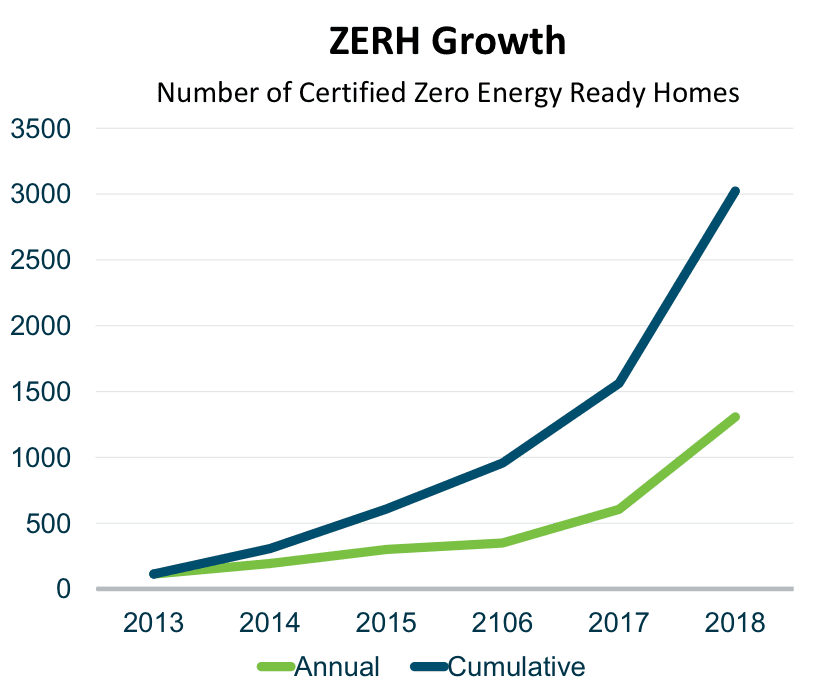
In case you haven’t been paying attention … zero has arrived!
Sam Rashkin of the Department of Energy highlights the growing interest in Zero Energy Ready Homes.
You may not have heard about the U.S. Department of Energy’s (DOE’s) Zero Energy Ready Home program (ZERH), but it’s rapidly becoming well known. In fact, the ZERH team has been capturing the attention of housing industry stakeholders around the nation and beyond. This includes growing interest with home builders, Home Energy Rating System (HERS) raters, building code officials, and home buyers. We believe this growth can be attributed to rigorous requirements that deliver a compelling value proposition: homes that are more livable with a whole new level of energy savings, comfort, health, and durability.
After years of steadily engaging the housing industry on this business case, ZERH is now at a tipping point. As the graph below illustrates, exponential growth is evidenced with certifications that have nearly doubled for three straight years and now exceed 3,000 homes. Moreover, program commitments moving forward now exceed 10,000 homes, and new partnership opportunities are arising regularly. Something major has happened.

When you step back and look at the larger zero movement beyond ZERH, it’s even more clear that zero has arrived. Consider the following statistics:
- The annual census of zero net energy and ZERH home certifications performed by the Net Zero Energy Coalition shows that growth has doubled from 2015 to 2017, to over 12,000 homes.
- A 2017 industry survey by Dodge Data and Analytics shows that the percentage of builders who have built or plan to build a net zero, near net zero, or net zero ready home has doubled from 21% in 2015 to 44% in 2019.
There are also promising signs from outside the industry. Nineteen mayors globally, including six in the U.S., have signed pledges to enact regulations and/or plan policies that ensure new buildings operate at net zero carbon by 2030 and all buildings by 2050. Net zero carbon means not only ZNE, but also no fossil fuels (all-electric with site-based source energy). Additionally, a growing number of states are enacting or plan to enact zero net energy building codes, including California and Oregon, along with stretch codes in Massachusetts, Rhode Island, and New York that approximate zero energy rigor.
In Northern California, the DOE ZERH team is working with the Clean Coalition and other local organizations to develop a template for rebuilding with resilience. DOE’s Solar Decathlon Build Challenge is also encouraging Californiauniversities tohelp developZNE homes and structures that can help the rebuilding effort following the devastating fires in the state, potentially becoming “model structures” for the rebuilding effort there and elsewhere in the nation.
The zero movement has taken off, and it’s coming to a housing market near you. Builders who engage sooner than later will enjoy tremendous differentiation and leadership benefits. Communities will benefit from residents who are healthier both physically and economically, and a stronger infrastructure of homes that will stand the test of time and be substantially more resilient. The ZERH team would love to have you join the program.
***********************************************************************************************
Sam Rashkin, Chief Architect of the U.S. DOE’s Building Technologies Office, was the primary author of the Energy Star program and now heads the U.S. DOE ZERH program, as well as the U.S. DOE Solar Decathlon competition. ZERH are homes that are so efficient that all or most of their energy consumption can be offset with renewable energy. The ZERH program is designed for builders to participate, and is tailored to help builders and technology partners develop homes that are ZNE or ZNE ready. The highest bar, which the program encourages, is to get Passive House certification through the Passive House Institute, U.S. (PHIUS). Certifying through the ZERH program combined with PHIUS certification results in a home or building that uses 80% – 90% less energy for heating and cooling – meaning you need less solar to be ZNE or even ZNE+ (Net Positive Energy). The dual certification can also satisfy green building code requirements in many jurisdictions. Speaking as a builder who has done this, I highly recommend it and am proud to say that all my work will be ZNE+ from here forward. – John Sarter, Program Manager, North Bay Community Resilience Initiative
